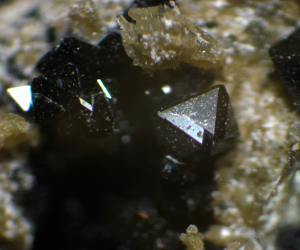Pleonaste
Pleonaste is an opaque, usually black, variety of Spinel containing iron. It may also be very dark blue or very dark green but is gernerally considered to be black and is often referred to as “black Spinel”. Pleonaste is an intermediate variety of the Hercynite-Spinel Series. It is essentially an iron-rich Spinel or a magnesium-rich Hercynite. Pleonaste is similar to another Spinel variety called Ceylonite, named for the island of Ceylon where it was discovered. The two varieties differ in that Ceylonite is a ferroan Spinel with little or no ferric iron and Pleonaste is distinguished chemically by its higher iron content.
Pleonaste was first cited in the first edition of René Just Haüy’s Crystallography in 1801 when he substituted the name Pleonaste for the name Ceylanite of Delamétherie. Haüy named Pleonaste from the Greek word for abundant referring to its numerous crystal forms. René Just Haüy (1743-1822) was a French mineralogist and is often referred to as the “Father of Modern Crystallography.” The mineral Haüyne was named to honor him. Ceylanite was first cited by Jean-Claude Delamétherie in his Journal de Physique in 1793. The name Ceylanite was later resurrected as Ceylonite, another variety of Spinel as described above. Jean-Claude Delamétherie (also de La Métherie or de Lamétherie) (1743–1817) was a French naturalist, mineralogist, geologist and paleontologist. Numerous minerals were first systematically named by Delamétherie and later substituted by Haüy. Another example of Haüy’s name substitutions is the substitution of the name Epidote for Thallite of Delamétherie.
One critisism of Haüy is that he did not adhere to some of the historical mineral naming rules. Most early mineralogists recognized the system of naming which had made its appearance during the time of the ancient Greeks and Romans out of the genius of the Greek language. They almost uniformly adopted the termination “ite” for new mineral names.
Abraham Werner is credited with the naming of many minerals with the ite termination such as Apatite, Aragonite, Augite, Chalcolite, Cyanite (Kyanite), Graphite, Leucite, Prehnite, Torberite and Witherite. Abraham Gottlob Werner (1749-1817) was a professor of mining and mineralogy at the Freiberg Mining Academy. He was an influential teacher and his ideas shaped early geological thought. Wernerite was named to honor him.
James D. Dana later stated in the American Journal of Science and Arts in 1867: “The ancient origin of this termination ite, its adoption for most of the names in modern mineralogy, its distinctive character and convenient application, make it evidently the true basis for uniformity in the nomenclature of the science.” James Dwight Dana (1813-1895) was an American geologist, mineralogist, volcanolorist and zoologist. The mineral Danalite was named to honor him.
| Category: | Oxide minerals Spinel group Spinel structural group |
| Chemical Formula: | (Mg,Fe)Al2O4 |
| Magnesium Iron Aluminum Oxide | |
| Crystal system: | Isometric |
| Color: | Various; red to blue to mauve, dark green, brown, black |
| Moh’s Hardness: | 7.5–8.0 |
| Specific gravity: | 3.6–3.9 |
| Refractive index: | 1.770-1.780 |
| Diaphaneity: | Transparent to translucent |
| Luster: | Vitreous |
| Optical Properties: | Isotropic |
| Fracture: | Conchoidal, uneven |
| Cleavage: | Indistinct |
| Pleochroism: | Absent |


